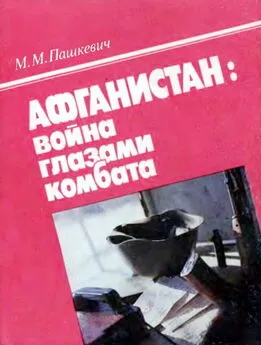Михаил Супотницкий - Биологическая война (Часть 3)
- Название:Биологическая война (Часть 3)
- Автор:
- Жанр:
- Издательство:Кафедра, Русская панорама
- Год:2013
- Город:Москва
- ISBN:978-5-93165-328-0
- Рейтинг:
- Избранное:Добавить в избранное
-
Отзывы:
-
Ваша оценка:
Михаил Супотницкий - Биологическая война (Часть 3) краткое содержание
Часть 3. Частная неправильная эпидемиология.
Биологическая война (Часть 3) - читать онлайн бесплатно полную версию (весь текст целиком)
Интервал:
Закладка:
Shannon J. G., Heinzen R. A. Adaptive immunity to the obligate intracellular pathogen Coxiella burnetii // Immunol Res. 2009. V. 43. № 1–3. P. 138–148.
Shannon J., Heinzen R. Adaptive immunity to the obligate Intracellular pathogen Coxiella burnetii // Immunol Res. 2009. V. 43. № 1–3. P. 138–148.
Sharma A., Lia X., Bangari D. S. el al. Adenovirus receptors and their implications in gene delivery // Virus. Res. 2009. V. 143. № 2. P. 184–194.
Shears N. Т., Ross P. M. Blooms of benthic dinoflagellates of the genus Ostreopsis; an increasing and ecologically important phenomenon on temperate reefs in New Zealand and worldwide // Harmful Algae. 2009. V. 8. P. 916–925.
Sherman М. B., Weaver S. Structure of the recombinant alphavirus Western equine encephalitis virus revealed by cryoelectron microscopy // J. Virol. 2010. V. 84. V. 19. P. 9775–9782.
Shimizu Y., Kobayashi M. Apparent lack of tetrodotoxin biosynthesis in captured Taricha torosa and Taricha granulose // Chem. Pharm. Bull. (Tokyo). 1983. V. 31. P. 3625–3631.
Shinzato Т., Furusu A., Nishino T. et al. Cowfish (Umisuzume, Lactoria diaphana) poisoning with rhabdomyolysis // Inter. Med. 2008. V. 47. P. 853–856.
Shvedova A., Kisin E ., Mercer R. et al. Unusual inflammatory and fibrogenic pulmonary responses to singlewalled carbon nanotubes in mice // Am. J. Physiol. Lung. Cell. Mol. Physiol. 2005. V. 289. L698-L708.
Sidell R. et al. — cm Medical aspects of chemical and biological warfare / Ed. F. R. Sidell, E. T. Ta-fuqi, D. R. Franz. Washington, 1997.
Silva Т., Costa E., Paixao T.et al. Laboratory animal models for brucellosis research // J. Biomed. Biotechnol. 2011, Article ID 518323. doi: 10.1155/2011/518323
Simionescu M. Lung endothelium: structure-function correlates // The Lung: Scientific Foundations, Raven, N.Y., 1991. P. 301–331.
Simon J., Hook R. Word war I gas warfare tactics and equipment. Oxford, 2007.
Sinclair R., Boone S.A., Greenberg D. et al. Persistence of category a select agents in the environment // Appl. Environ. Microbiol. 2008. V. 74. № 3. P. 555–563.
Singer O., Verma I. M. Applications of lentiviral vectors for shRNA delivery and transgenesis // Curr. Gene Ther. 2008. V. 8. № 6. 483–488.
Sirisanthana Т., Brown A. E. Anthrax ofthe gastrointestinal tract // Emerg. Infect. Dis. 2002. V. 8. P. 649–651.
SkocajM., FilipicM., PetkovkJ. et al. Titanium dioxide in our everyday life; is it safe? // Radiol. Oncol. 2011. V. 45. P. 227–247.
Skold O. Resistance to trimethoprim and sulfonamides // Vel. Res. 2001. V. 32. P. 261–273.
Silva K., Schnierle B. From actually toxic to highly specific — novel drugs against poxviruses // Virol. J. 2007. V. 4. № 8 (doi: 10.1186/1743-422X-4-8).
Smith D. H. R factor infection of Escherichia coli lyophilized in 1946 // J. Bact. 1967. V. 94. P. 2071–2072.
Smith J. F., Davis K., Hart М. K. et al. Viral encephalitidis // Medical aspects of Chemical and Biological Warfare/Ed. F. R. Sidell, E. T. Tafuqi, D. R. Franz. Washington, 1997. P. 561–589.
Smith K. I., Devos V., Bryden H. et al. Bacillus anthracis diversity in Kruger national park // J. Clin. Microbiol. 2000. V. 38. № 10. P. 3780–3784.
Smith P., Giroud М., Wiggins H. et ah Cellular entry of nanoparticles via serum sensitive clathrin-mediated endocytosis, and plasma membrane permeabilization // Inter. J. of Nanomed. 2012. V. 7. P. 2045–2055.
Smoragiewicz W. et al. Trichothecene mycotoxins in the dust of ventilation systems in office buildings // International archives of occupational and environmental health. 1993. V. 65. P. 113–117.
Song H., Hwang J., Yi H. et al. The early stage of bacterial genome-reductive evolution in the host // PLoS Pathog. 2010. V. 6. № 5 (e1000922. doi:10.1371/journal.ppat.1000922).
Song I., Hobaugh М., Shustak C. et al. Structure of staphylococcal alpha-hemolysin, a heptameric transmembrane pore // Science. 1996. V. 274. № 14. P. 1859–1866.
Song Y., Li X., Du X. Exposure to nanoparticles is related to pleural effusion, pulmonary fibrosis and granuloma // Eur. Respir. J. 2009. V. 34. P. 559–567.
Song Y., Li X., Wang L. et al. Nanomaterials in humans: identification, characteristics, and potential damage // Toxicol. Pathol. 2011. V. 39. P. 841–849.
Sonnabend W. P., Sonnabend U. P., Heinzle R. et al. Isolation of Clostridium botulinum type G and identificat.on of type G botulinal toxin in humans: report of five sudden unexpected deaths // J. Infect Dis. 1981. V. 143. № 1. P. 22–27.
Sonnabend W. P., Sonnabend U. P., Kresch T. Isolation of Clostridium botulinum type G from Swiss soil specimens by using sequential steps in an identification scheme // Appl. Environ. Microbiol. 1987. V. 53. № 8. P. 1880–1884.
Sosa S., Del Favero G., De Bortoa Met. al Falytoxin toxicity after acute oral administration in mice // Toxicol. Lett. 2009. V. 191(2–3). P. 253–259.
Soto P. J., Roessler W. G. Staphylococcal enterotoxemia: pathologic lesions in rhesus monkeys exposed by aerosol // Techn.cal Manuscript 226. U.S. Government Printing Office, Washington. 1965. P. 1—16.
Speyer J. P. A simple and effective electroporation apparatus // Bio Technigue. 1990. V. 8. № 1. P. 28 30.
Spicer A. J., Peacock M.G., Williams J. С Effective,
Spratt B. G. Independent review of the possible health hazards of the large-scale reiease of bacteria during the Dorset defense trials. 1999 (MoD Website http://www.mod.uk).
Steed W. Aerial warfare: secret German plans // The Nineteenth century and after. 1934. July. V. 116. P. 1—15.
Stenseth N., Atshabar В. B., Begon M. et al. Plague past, present, and future // PLoS Med. 2008. V. 5. № 1. e3. doi: 10.1371/journal.pmed.0050003.
Stepanov A. V., Marinin L. I., Pomerantsev A. P. et al. Development of novel vaccines against anthrax in man // J. Biotechnol 1996. V. 44. P. 155–160.
Stephenson E. H, Larson E. W., Dominik J. W. Lffect of environmental factors on aerosol-induced Lassa virus infection // J. Med. Virol. 1984.V. 14. № 4. P. 295–303.
Stern S., McNeil S. Nanotechnology safety concerns revisited // Toxicol. Sci. 2008. V. 101. V. 4—21.
Strahilevitz J., Jacob) G. A., Hooper D. C. et al. Plasmid-mediated quinolone resistance: a multifaceted inreat // Clin. Microbiol. Rev. 2009. V. 22. № 4. P. 664 689.
Strauss В. E. et al. Combating oncogene activation associated with retrovirus-mediated gene therapy of X-linked seveie combined immunodeficiency // Brazil. J. Med. Biol. Res. 2007. V. 40. P. 601–613.
Strong J. E, Wong G., Jones S. E. et al. Sumulauon of Ebola virus production from persistent infection through activation of the Ras/MAPK pathway // PNAS. 2008. V. 105. № 46. P. 17982-17987.
Stuken A., Orr R. J. S., Kellmann R. et al. Discovery of nuclear-encoded genes for the neurotoxin saxitoxin in Dinoflagellates // PLoS ONE. 2011. V. 6. № 5 (e20096. doi:10.1371/journal.pone.0020096).
Su J., Yang J., Zhao D. et al. Genome-wide identification of Francisella tularensis virulence determinants // Infect. Immun. 2007. V. 75. P. 3089–3101.
Su K., Wang D., Ye J. et al. Site-specific integration of retroviral DN A m human cells using fusion proteins consisting of human immunodeficiency virus type 1 nitegrase and the designed polydactyl zinc-finger protein E2C // Methods. 2009. V. 47. № 4. P. 269–276(doi: 10 1016/j.ymeth.2009 01 001.).
Suh E. М., Kishi Y. Synthesis of palytoxin from palytoxin carboxylic acid // J. Am. Chem. Soc 1994. V. 116. P. 11205-11206.
Suhan M. L., Chen S. Y., Thompson H. A. Transformation of Coxiella burnetii to ampicillin resistance // J. Bacteriol. 1996 V 178. № 9. P. 2701–2708.
Sui L. М., Chen K., Hwang P. A. et al. Identification of tetrodotoxin in marine gastropod implicated in food poisoning // J. Nat. Toxins 3002. V. 11. V. 213–220.
Suk J. S., Suh J., Lai S. K. et al. Quantifying the intracellular transport of viral and nonviral gene vectors in primary neurons // Exp. Biol. Med. (Maywoou) 2007 V. 232. P. 461–469.
Sullivan N., YangZhi-Yong., NabeIG J. Ebola virus pathogenesis: implications for vaccines and therapies // J. Virol. 2003. V. 77. № 18. P. 9733–9737.
Suzuki Y., Gojobori T. The origin and evolution of Ebola and Marburg viruses // Mo 1. Biol. Evol. 199 7V. 14. № 8. P. 800–806.
Takada A., Ebihara H., Peldmann H. et al. Epitopes required for antibocy-dependent enhancement of Ebola virus infection // J. Infec. Dis. 2007. V. 196. P. 347–356.
Takada A., Feldmann H., Ksiazek T. G. et al. Annoody-depend;nt enhancement of Ebola virus infection // J. Virol 2003. V. 77. № 13. P. 7539–7514
Takada A., Watanabe S. Okazak K. et al. Infectivity-Enhancing antibodies to Ebola virus glycoprotein // J. Virology. 2001. V. 75. № 5. P. 2324–2330.
Takahashi Н., Keim P., Kaufmann et al. Bacillus anthracis incident, Kamtido, Tokyo, 1993 1j Emerg. Infect. Dis. 2004. V. 10. № 1. P. 117–119.
Takahata N. Neutral theory of molecular evolution // Curr. Opin. Genet. Dev. 1996. V. 6. № 6. P. 767–772.
Takano Т., Kawakami S., Yamada S. et al. Antibody-dependent enhancement occurs upon re-infection with the identical serotype virus in feline infectious peritonitis virus infection // J. Vet. Med Sci. 2008 V. 70. № 12. P. 1315–1321.
Tan C. Т. T., Lee E. J. /X A fatal case of crab toxin (Lophozozyinus pictor) poisoning // Asia Рас. J. Pharmacol. 1988. V. 3. P. 7–9.
Taniyama S., Arakawa O., Terada M. et al. Ostreopsisspa possible origin of palytoxin (PTX) in parrotfish Scarus ovifrons // Toxicon. 2003. V. 42. P. 29–33.
Tamvik A., Berglund L. Tularaemia // Eur. Respir. J. 2003. V. 21. P. 361–373.
Tavakoli N., Comanducci A., Dodd H. M. et al. IS 1294, a DNA element mat transposes by RC transposition // Plasmid. 2000. V. 44 № 1. P. 66–84.
Taylor R. R. Report on tularemia Its d,agnosis, and treatment // J. Arkansas M See. 1950. V.47.P 47.
Teaie A. et al. Orthopoxviruses require a functional ubiquitin-proteasome system for productive replication // J. Virol. 2009. V. 83. P. 2099 2108.
The problem of chemical and biological warfare SIPRI, 1970.
Thibault F. М., Hernandez £., Vidal D. R. et al. Antibiotic susceptibility of 65 isolates of Burkholderia pseudomallei and Burkholderia mallei to 35 antimicrobial agents // J. Anf imicrob. Chemother 2004. V. 54. P. 1134–1138.
Thierry А. Патент 5908635 (А) США, МП К 6A61K9/I27B2; C12.N15/88. Method forthe liposomal delivery of nucleic acids / заявитель Man Thierry: патентообладатель The United States of America as iepre-sented by the Dep. of Health and Human Service; заявл. 05.08.1994,08/286,730; опубл. 01.06.1999.
Thomas С, KelecherM F., McKee A. P. Botulism a complication of Clostiidium botulinum wound infection // Arch. Pathol. 1951. V. 51, № 6. P. 623–628.
Thompson IV. L., Wunnemacher R. W. Structure-function relationships of 12,-13-epoxytiicothecene mycotoxins in cell culture: comparison to whole animal lethality // Toxicon. 1986. V. 24. P. 985.
Читать дальшеИнтервал:
Закладка:
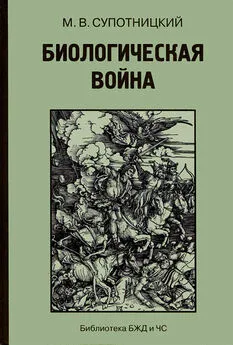
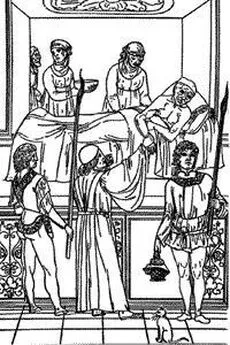

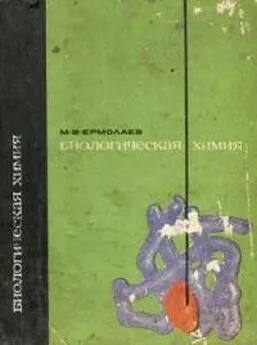

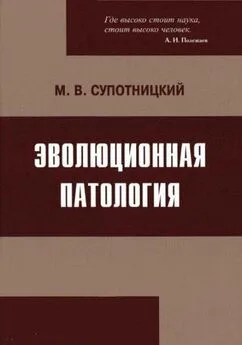
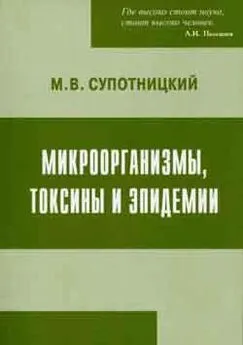
![Михаил Супотницкий - Очерки истории чумы. Книга II. Чума бактериологического периода [без иллюстраций]](/books/1084186/mihail-supotnickij-ocherki-istorii-chumy-kniga-ii.webp)
![Михаил Супотницкий - Очерки истории чумы. Книга I. Чума добактериологического периода [без иллюстраций]](/books/1084187/mihail-supotnickij-ocherki-istorii-chumy-kniga-i-ch.webp)
